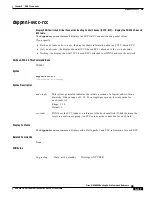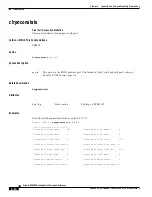
6-7
Cisco MGX 8850 Routing Switch Command Reference
Release 2.0, Part Number 78-10467-04 Rev C0, October 2001
Chapter 6
Logical Node, Port, and Signaling Commands
addaddr
Related Commands
deladdr, dspaddr
length
Address length. The units of measure differ for each address plan. The -plan option lets
you specify E.164 or NSAP.
•
For an NSAP address plan, the units of measure are bits. The range is 0–160. Using
the maximum of a 20-byte ATM address: 20 bytes x 8 bits per byte = 160 bits.
•
For an E.164 address plan, the value is the number of decimal digits. If the ATM
address consists of 15 digits, the value for this parameter is also 15.
-type
The type of reachability of the node. The reachability is either internal or external. For
internal, the address of this port is advertised to only the nodes within the current PNNI
network. The default is internal.
The external address can go outside the PNNI network and applies to an IISP link or a
public UNI. For example, the boundary node on the far side of an IISP link must have
access to the ATM address of the near-side boundary node to be able to reach the
near-side boundary node. Note that, for any ATM address on an IISP port or a public
UNI, you must specify external.
Possible entries: “internal” (or just “int”” or “external (or just “ext”).
Default: int
-proto
The protocol for advertising a reachable address:
•
If the -type is internal, enter local for the -proto parameter.
•
If the -type is extenal, enter static for the -proto parameter.
Possible entries: local or static.
Default: local
-plan
The address plan: E.164 or NSAP. If you choose NSAP address, the first byte of the
address implies one of the three NSAP address plans: NSAP E.164, NSAP DCC, or
NSAP ICD. For example, 47 is reserved for NSAP ICD (see Example section).
Valid entries: e164 or nsap
Default: nsap
-scope
The PNNI hierarchal level to which the address is advertised. In a single-peer group
(SPG), only ‘0’ applies. This release does not support multiple peer groups.
Range: 0–104
Default: 0
-redst
Enable for distribution of a static address. Enter “yes” to enable (distribute) or “no” to
disable (do not distribute). Enabling this option means that the address you are now
adding is visible to all nodes within the PNNI network. Other networks cannot see
specific port addresses unless you enable such addresses for distribution.
Default: no
















































